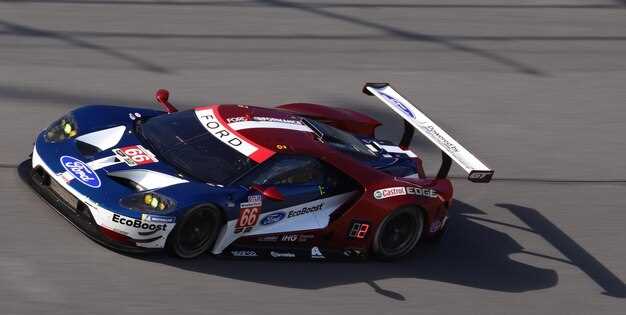
The Porsche 917 stands as a monumental icon in the realm of endurance racing, forever altering the landscape of events like the Le Mans 24 Hours. Launched in the late 1960s, the 917 was engineered to break records and challenge the limits of automotive performance. Its innovative design and powerful engine revitalized the idea of endurance racing, pushing boundaries that were previously thought insurmountable.
With its sleek aerodynamics and lightweight structure, the 917 became a formidable contender on the racetrack. The car’s success at Le Mans in 1970 and 1971 not only marked a new chapter for Porsche but also set a benchmark for competitors. The 917’s ability to maintain high speeds over long distances redefined what performance meant in endurance racing, compelling teams to rethink their strategies and engineering approaches.
Moreover, the legacy of the Porsche 917 extends beyond mere statistics and victories. It ignited a passion for endurance racing in fans and drivers alike, inspiring a generation to appreciate the art and science behind racing. The car’s impact resonates today, as its design principles continue to influence modern racing vehicles, underscoring the profound mark the 917 has left in endurance racing history.
Performance Innovations Introduced by Porsche 917

The Porsche 917 is widely regarded as a groundbreaking vehicle that revolutionized endurance racing through a series of innovative performance enhancements. One of the most significant innovations was its lightweight design, achieved through the extensive use of aluminum and composite materials. This focus on reducing weight allowed the 917 to achieve remarkable speed and agility on the race track.
Additionally, the 917 introduced a powerful engine setup that featured a flat-12 configuration. This engine not only provided exceptional horsepower but also contributed to a lower center of gravity, improving handling and stability during high-speed maneuvers. Coupled with advanced aerodynamics, the Porsche 917 could efficiently cut through the air, maximizing both speed and fuel efficiency.
Another critical innovation was the incorporation of enhanced braking systems. The 917 utilized larger disc brakes, offering superior stopping power and reliability. This improvement enabled drivers to maintain higher speeds while still being able to navigate the challenging turns of endurance circuits with confidence.
Furthermore, the 917 was among the first to utilize a sophisticated chassis dynamic system, including adjustable suspension settings. This feature allowed teams to fine-tune the car’s setup for specific tracks and conditions, optimizing performance over varying terrains and weather scenarios.
Overall, the Porsche 917’s contributions to performance innovations not only set new standards in endurance racing but also influenced the design and engineering of subsequent racing vehicles. Its legacy continues to shape the approach to performance in motorsport today.
Key Races and Victories of the Porsche 917 at Le Mans

The Porsche 917 made its mark in endurance racing history primarily through its performances at the 24 Hours of Le Mans. Debuting in 1969, the 917 represented a significant engineering achievement, showcasing a powerful flat-12 engine and a groundbreaking aerodynamic design that set new benchmarks for speed and efficiency on the track.
In 1970, the 917 won its first significant race at Le Mans, finishing in first place with a stunning display of reliability and speed. The race was characterized by intense competition; however, the 917’s superior engineering allowed it to dominate the field. Drivers Hans Hermann and Richard Attwood piloted the iconic car, securing a historic victory for Porsche.
The following year, in 1971, the Porsche 917 continued to solidify its legacy by achieving another remarkable win at Le Mans. This time, the tackling team consisted of Jacky Ickx and Derek Bell, whose exceptional driving skills coupled with the car’s impressive performance led to a commanding triumph. The 917’s aerodynamic prowess was evident as it consistently outpaced its rivals, affirming its status as a leading contender in endurance racing.
In total, the Porsche 917 earned numerous accolades at Le Mans, contributing to a legacy that would influence the design and development of future racing cars. Its victories not only highlighted the engineering advancements achieved by Porsche but also underscored the car’s capability in endurance racing, ensuring its place in motorsport history.
Legacy of the Porsche 917 on Modern Endurance Racing
The Porsche 917 is often hailed as a pioneer in the realm of endurance racing, establishing benchmarks that still resonate in contemporary motorsport. Introduced in the late 1960s, the 917’s lightweight construction, powerful flat-12 engine, and innovative aerodynamics provided a competitive edge that transformed racing strategies. This model not only secured Porsche’s dominance at prestigious events like the 24 Hours of Le Mans but also revolutionized design philosophies in race cars.
Modern endurance racing heavily benefits from the innovations brought about by the 917. The emphasis on aerodynamics, seen in the low drag profile and effective downforce of the 917, has become a cornerstone in the design of today’s prototypes. Manufacturers now prioritize weight reduction and efficiency, echoing the lessons learned from the pioneering feats of the Porsche team during the late 1960s and early 1970s.
The 917 also generated a legacy of collaborative engineering and relentless pursuit of performance, inspiring modern teams to adopt a multi-disciplinary approach in vehicle design. The integration of cutting-edge technology, such as hybrid systems and advanced telemetry, can be traced back to the spirit of innovation that the 917 embodied. This vehicle did not just compete; it set an example of how to harness the synergy between engineering excellence and racing success.
Furthermore, the allure of the 917 extends beyond technical advancements; it has become an icon within the sport, influencing car culture and inspiring countless enthusiasts. The narratives of legendary drivers who achieved glory in the 917 continue to motivate new generations in endurance racing, emphasizing the significance of teamwork and strategic ingenuity inherent to this discipline.
In summary, the legacy of the Porsche 917 remains profoundly influential in modern endurance racing. Its innovations set new standards, molded design methodologies, and fostered a lasting passion for the sport that continues to thrive today. As teams push boundaries in search of performance, they pay homage to the groundbreaking achievements of the Porsche 917, solidifying its place in the annals of racing history.
 Skip to content
Skip to content




